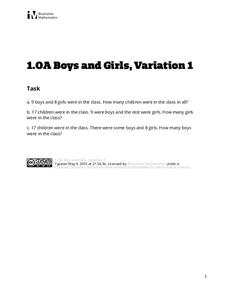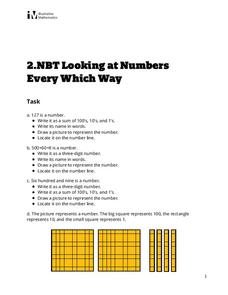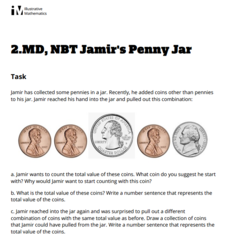Illustrative Mathematics
Boys and Girls, Variation 2
How many ways can you make the number 9? Use a task that has pupils thinking about the many different ways a classroom of nine can be made up of boys and girls.
Illustrative Mathematics
Boys and Girls, Variation 1
Given a certain amount of boys and certain amount of girls, how many children are there total in the class? Assess learners' ability to use addition and subtraction strategies when solving word problems.
Illustrative Mathematics
The Pet Snake
Assess how long the class pet snake grew and how long it was when it started growing with a short worksheet. Learners use addition and subtraction strategies with measurements to answer three questions.
Illustrative Mathematics
Looking at Numbers Every Which Way
Assess class members' ability to look at numbers every which way. A helpful learning exercise contain four tasks, including writing numbers as a sum of 100's, 10's, and 1's, and drawing a picture to represent the number.
Fluence Learning
Divide Shapes
Let's partition rectangles into equal parts. Assess learners on their ability to divide shapes into equal parts, and their ability to explain their thinking.
Illustrative Mathematics
Comparisons 1
A seven question worksheet asks learners to use place value strategies to decide if each number comparison is true or false.
Illustrative Mathematics
Making 124
How many ways can you make the number 124 using only tens and ones? Use a task that prompts young mathematicians to make 124 in as many ways as possible.
Illustrative Mathematics
One, Ten, and One Hundred More and Less
What's 1 more or less than a number? What's 10 more or 10 less than a given number? What's 100 more or 100 less than a number? These are the types of problems learners must answer in a six-question worksheet.
Illustrative Mathematics
Saving Money 2
Adding money is a key skill in life. Give a worksheet that requires second graders to find the total amount of money Louis needs to make certain school supply purchases.
Illustrative Mathematics
Regrouping
What number does 6 tens and 16 ones represent? How is it different from or similar to the number that 7 tens and 6 ones represent? This is the type of questions learners are asked to solve as a way to understand the concept of regrouping.
Illustrative Mathematics
Red and Blue Tiles
Here, second graders are tasked to find the patterns that have an even number of tiles. They are asked to think about why these patterns are even or odd and explain how they know.
Illustrative Mathematics
Largest Number Game
Learners are asked to make the largest three-digit number they can with the numbers 1, 8, and 5 in a quick assessment worksheet.
Illustrative Mathematics
Digits 2-5-7
Given three digits, what is the largest humber you can make? What is the smallest number you can make? These are the questions second graders are prompted to answer in a three-question quiz.
Illustrative Mathematics
Bundling and Unbundling
Seven tens, plus five ones, equals 75. Five ones, plus seven tens, also equals 75. These are the types of equations learners are asked to make true in a worksheet with 11 unfinished equations.
Illustrative Mathematics
Jamir's Penny Jar
Before you start counting the coins in Jamir's coin jar, figure out which coin to start with. Should it be the penny or the quarter? Why? This is the focus around a learning exercise that works well as an assessment on counting money and...
Fluence Learning
Writing a Narrative: How Bear Lost His Tail
After reading the first, second, and third parts of "How Bear Lost His Tail", third grade writers answer questions about the story by completing a series of options, including discussion points. Then, they begin to plan a new narrative...
Illustrative Mathematics
Sharing Markers
Let your first graders translate these word problems into subtraction sentences. Some of the equations involve finding the answer after Char gives some of her markers away, while others require finding the amount of markers Char started...
Fluence Learning
Writing Informational Text: Lemonade Stand
Use a performance task to assess third graders' ability to read informational text. After they plan a lemonade stand business, young entrepreneurs implement that plan through informational writing. The task assumes learners can...
Illustrative Mathematics
Which Pictures Represent One Half?
Which image represents one half? Answer the question surrounding four shapes, some of which represent one half and others representing a different amount. The last two questions ask learners to explain why some shapes represent one half...
Illustrative Mathematics
Representing Half of a Rectangle
Did you know one half of a rectangle be represented in more than one way? Young mathematicians choose the rectangles that represents one half with an instructive worksheet.
Illustrative Mathematics
Maria’s Marbles
Ali has more marbles than Maria in some of these word problems, while in others Maria has more marbles than Ali. First graders are tasked to read each word problem and solve how many marbles each girl has.
Illustrative Mathematics
School Supplies
First graders are tasked to find the amount of money in dollars Pia came to the store with, after she bought five dollars worth of school supplies.
Illustrative Mathematics
Counting Dots in Arrays
Mathematical arrays can represent several different math skills, including counting groups, multiplication, and even area. In this specific task, learners are asked to identify the addition equations that are equal to a 3 x 4 array....
Illustrative Mathematics
Valid Equalities?
True or false: 20 = 10 + 10. The statement is true because two 10s make a 20. These are the types of equations learners must label or false. They must also explain in mathematical terms how they know.

























